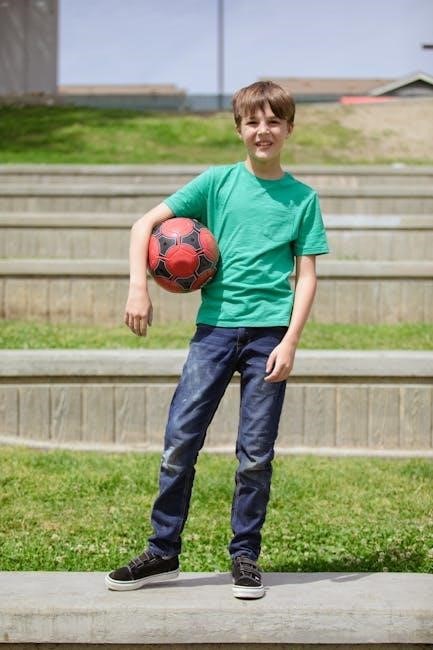
soccer ball size guide
Soccer ball sizes vary, designed for different age groups and needs. Choosing the right size is crucial for performance and skill development. This guide provides a comprehensive overview to help you make an informed decision.
Why Soccer Ball Size Matters
Soccer ball size plays a critical role in player performance and development. Properly sized balls ensure better control, accuracy, and handling, especially for younger players. Using the wrong size can hinder skill development, as smaller balls are easier to manage for children, while larger ones are designed for advanced play. The right size also enhances safety, as a ball that is too heavy or large can increase the risk of injury. Additionally, official matches require balls to meet specific size standards, making it essential to choose the correct one for both training and competition. Ultimately, the right ball size is foundational for optimal performance and enjoyment of the game.
Overview of Standard Soccer Ball Sizes
Soccer balls are categorized into five standard sizes, each designed for specific age groups and purposes. Size 1 is a skills ball, ideal for young children learning basic techniques. Size 3 is suited for juniors aged 5-8, offering a balance between control and portability. Size 4 is the youth ball, used by players aged 9-12, preparing them for competitive play. Size 5 is the official match ball for players aged 13 and above, adhering to FIFA regulations. The size affects performance, control, and safety, making it essential to choose the correct one for optimal gameplay. These standards ensure consistency across all levels, from training to professional matches, while catering to the developmental needs of players at every stage.
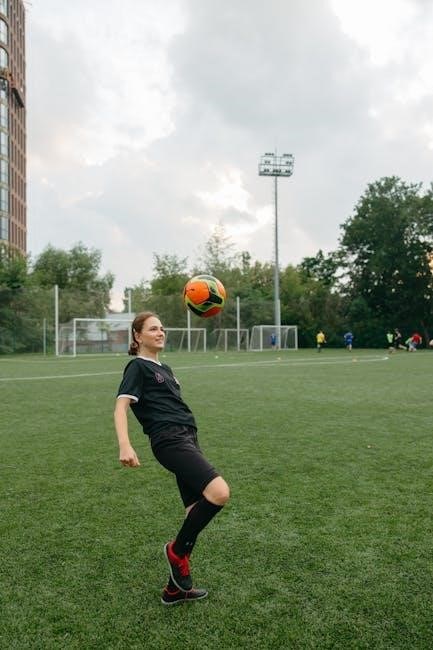
Soccer Ball Size Guidelines by Age Group
Soccer ball size guidelines help players choose the right ball for their age. Size 1 is for ages 1-4, Size 3 for 5-8, Size 4 for 9-12, and Size 5 for 13+. Proper fit enhances performance and safety.
Size 1: Skills Ball (1-4 Years)
Size 1 soccer balls are designed for young children aged 1-4 years. These balls are smaller and lighter, making them ideal for developing basic motor skills and hand-eye coordination. Their compact size allows for easier control and handling, encouraging young players to practice dribbling and ball manipulation. The reduced weight also ensures safety, minimizing the risk of injury during play. Size 1 balls are often used in training sessions and introductory soccer programs, helping toddlers build confidence and a love for the game. They are a great starting point for little ones just beginning their soccer journey.
Size 3: Junior Ball (5-8 Years)
Size 3 soccer balls are tailored for children aged 5-8 years. These balls are slightly larger and heavier than Size 1, providing a better feel for young players. The size and weight are designed to help develop ball control, dribbling, and basic techniques. Size 3 balls are ideal for training sessions and small-sided games, allowing children to build confidence and improve coordination. They are commonly used in youth soccer leagues and practices, serving as a transitional step toward larger ball sizes; This size is perfect for fostering skills in junior players while ensuring the ball remains manageable for their age and ability level.
Size 4: Youth Ball (9-12 Years)
Size 4 soccer balls are designed for players aged 9-12 years, offering a balance between control and power. Weighing between 13-15 ounces, this size is ideal for developing advanced techniques and preparing for competitive play. It is commonly used in youth leagues and training sessions, helping players refine their ball control, passing, and shooting skills. The slightly smaller circumference compared to Size 5 makes it easier to handle for younger players, while still providing a realistic feel for the game. Size 4 balls are a transitional step toward the official match ball, ensuring players are well-prepared for the next level of competition.
Size 5: Official Match Ball (13+ Years)
Size 5 soccer balls are the official match balls used for players aged 13 and above, including professional and adult leagues. Weighing between 14 and 15 ounces, they are the largest and heaviest option, designed for optimal performance. FIFA regulations require Size 5 balls to meet specific standards for weight, size, and air pressure, ensuring consistency in professional and competitive play. The balls are typically made from high-quality materials, such as leather or advanced synthetic compounds, and feature precise stitching for durability and aerodynamics. Size 5 balls are essential for serious players, as they provide the authentic feel and responsiveness needed for advanced techniques and high-level competition. Always check for FIFA certification to ensure quality and adherence to official standards.
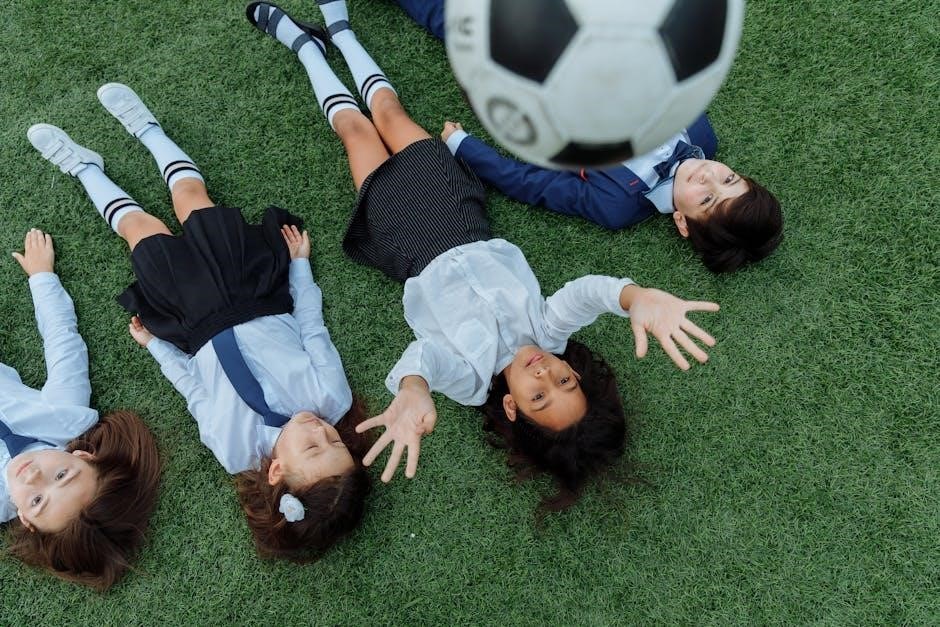
Materials and Construction of Soccer Balls
Soccer balls are made from materials like leather, synthetic leather, or rubber, with constructions ranging from machine-stitched to seamless designs, ensuring durability and aerodynamic performance.
Machine-Stitched Soccer Balls
Machine-stitched soccer balls are constructed using automated stitching technology, offering consistent and durable seams. This method ensures uniformity and is commonly used for mid-range to high-end balls, providing a balance between performance and affordability. The stitching process enhances the ball’s shape retention and aerodynamics, making it suitable for both training and competitive play. Machine-stitched balls are known for their reliability and are often recommended for players seeking a blend of quality and cost-effectiveness. They are widely available and meet FIFA’s quality standards, ensuring they perform well across various playing surfaces and conditions.
Hand-Stitched Soccer Balls
Hand-stitched soccer balls are crafted with precision, offering exceptional quality and durability. Each stitch is carefully sewn by skilled artisans, ensuring a consistent and tight seal. This traditional method enhances the ball’s feel and control, making it a favorite among professional players. Hand-stitched balls are known for their soft touch and precise aerodynamics, providing superior performance on the field. They often meet FIFA’s highest standards for match play, making them a top choice for serious athletes. While more expensive than machine-stitched options, hand-stitched balls are prized for their craftsmanship and longevity, delivering outstanding performance for both training and competitive games.
Seamless Molded Panel Soccer Balls
Seamless molded panel soccer balls are constructed using advanced thermal bonding technology, eliminating the need for stitching. This design creates a smooth, consistent surface for better ball control and aerodynamics. The seamless construction reduces water absorption, making them ideal for play in wet conditions. These balls are durable and maintain their shape well, offering excellent performance for training and recreational play. They are often used by players who prefer a softer touch and less weight. While they may not meet FIFA’s highest standards for professional matches, seamless balls are a popular choice for their affordability and low-maintenance design, making them suitable for a wide range of players and playing surfaces.
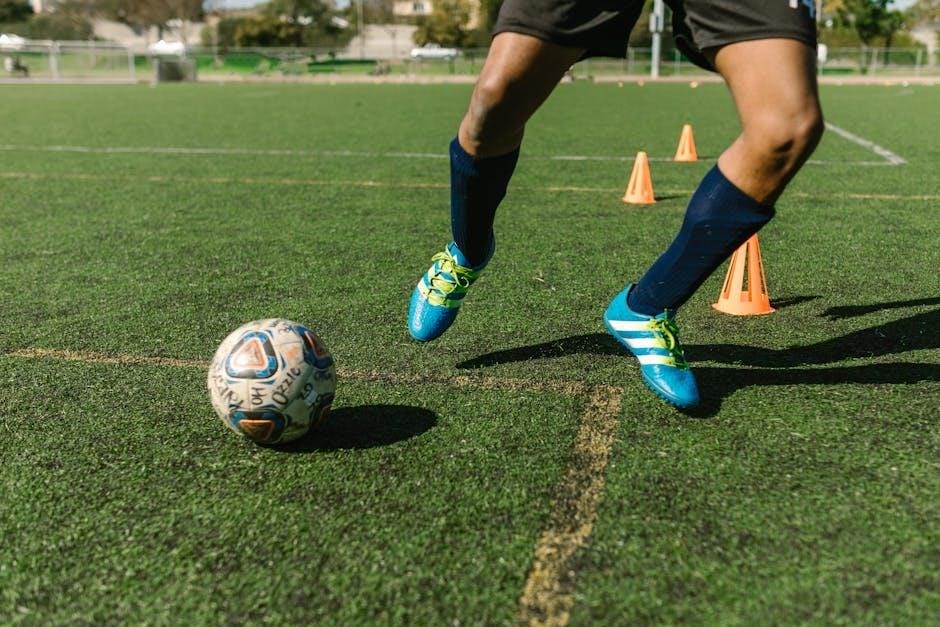
Maintenance and Care for Soccer Balls
Proper care ensures longevity and performance. Avoid harsh chemicals, excessive heat, and rough surfaces. Regularly check for wear and tear to maintain optimal condition and playability.
Proper Inflation Techniques
Proper inflation is crucial for optimal performance and durability. FIFA regulations specify that a soccer ball must be inflated to between 8.5 psi and 15.6 psi. Use a high-quality pressure gauge to ensure accuracy. Over-inflation can make the ball too hard and difficult to control, while under-inflation may cause poor performance and potential damage. Always inflate the ball just before use, as prolonged high pressure can strain the bladder and panels. For younger players or training sessions, slightly lower pressure (around 8.5-12 psi) is recommended for better control. Regularly check the ball’s pressure, especially in varying temperatures, as this can affect air pressure levels.
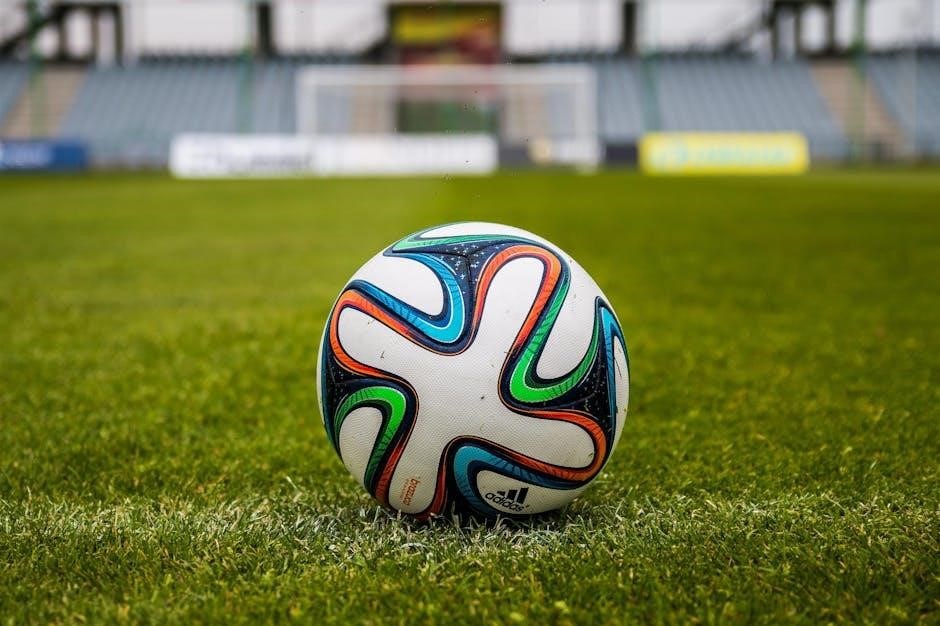
Cleaning and Washing Tips
Regular cleaning is essential to maintain your soccer ball’s performance and longevity. Use a soft, damp cloth with mild soap to wipe away dirt and grime. Avoid harsh chemicals or abrasive materials, as they can damage the ball’s surface. For machine-stitched balls, gently scrub the seams with a soft-bristled brush. Never submerge the ball in water, as it can damage the internal bladder. After cleaning, allow the ball to air dry completely before storing or using it again. For stubborn stains, mix a small amount of dish soap with warm water and apply it gently. Always follow the manufacturer’s care instructions for specific materials. Proper cleaning ensures the ball remains responsive and maintains its shape for optimal play.
Storage and Handling Best Practices
Proper storage and handling are crucial for maintaining the quality and performance of your soccer ball. Store the ball in a cool, dry place away from direct sunlight to prevent the materials from deteriorating. Avoid leaving the ball in extreme temperatures or humid environments, as this can affect its air pressure and structural integrity. When not in use, keep the ball deflated or at the recommended pressure to prevent over-inflation stress. Use a ball bag or cover to protect it from dust and scratches. Never squeeze or compress the ball excessively, as this can damage the internal bladder. Always handle the ball with care to avoid punctures or abrasions. Following these practices ensures your soccer ball remains in optimal condition for years of reliable performance.
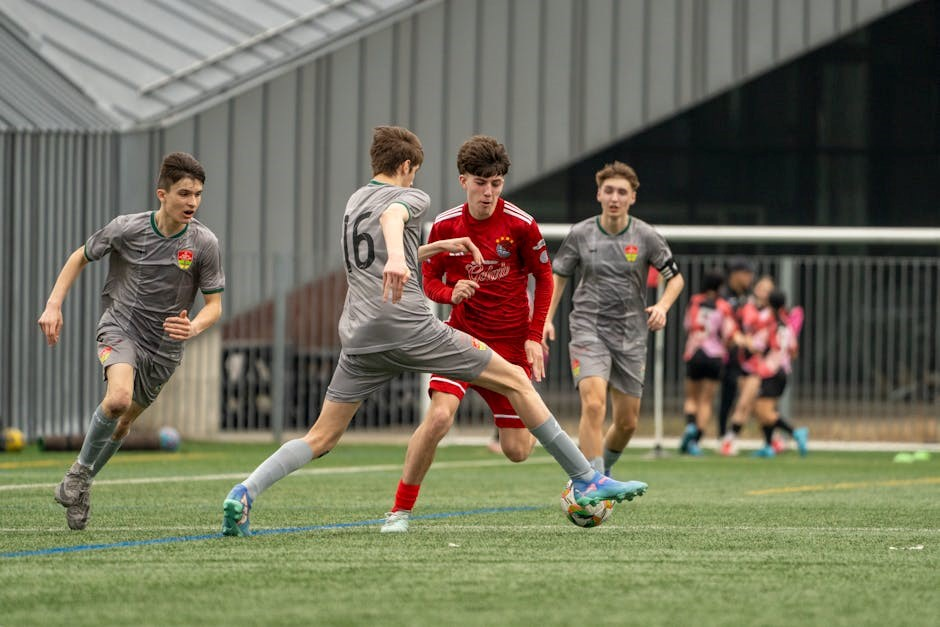
Regulations and Standards for Soccer Balls
Regulations ensure soccer balls meet safety and performance standards. FIFA approves sizes, materials, and air pressure requirements for official matches, guaranteeing consistency and fairness across all levels of play.
- FIFA standards dictate size, weight, and rebound characteristics.
- Official balls must meet specific air pressure requirements.
- Compliance ensures fair play and optimal performance.
FIFA-Approved Soccer Ball Sizes
FIFA sets strict standards for soccer ball sizes to ensure consistency worldwide. Their regulations specify that official match balls must be size 5, weighing between 14 and 15 ounces, with a circumference of 22 inches. The ball must maintain an air pressure between 8.5 and 15.6 psi. These standards apply to professional and international matches, ensuring fair play and optimal performance. FIFA also certifies balls for younger players, with sizes 3 and 4 for youth leagues. Compliance with these standards guarantees that the ball meets safety and quality requirements, making it suitable for all levels of competition.
Official Air Pressure Requirements
Official soccer balls must meet specific air pressure standards to ensure optimal performance. FIFA regulations require that match balls maintain an air pressure between 8.5 psi and 15.6 psi. This range ensures the ball has the correct bounce and responsiveness during play. Proper inflation is crucial for consistency and safety, as under-inflated balls may not perform correctly, while over-inflated balls can be difficult to control. Referees typically check the ball before matches to verify compliance with these standards. Maintaining the recommended pressure ensures the ball meets FIFA’s quality and safety requirements, providing a fair and enjoyable game for all players.

Choosing the Right Soccer Ball for Your Needs
Selecting the right soccer ball involves considering size, material, and intended use. Ensure it matches your age group, skill level, and playing surface for optimal performance and enjoyment.
How to Select the Correct Size for Your Age Group
Selecting the right soccer ball size for your age group ensures optimal performance and safety. Size 1 is ideal for children aged 1-4, focusing on skills development. Size 3 suits juniors aged 5-8, offering a balance between control and maneuverability. For youth players aged 9-12, Size 4 is recommended, providing the right weight and feel. Size 5 is the official match ball for players aged 13 and above, designed for professional and competitive play. Always check FIFA-approved standards and guidelines to ensure the ball meets your needs. Proper fit enhances both skill development and enjoyment of the game.
Factors to Consider for Skill Level and Playing Surface
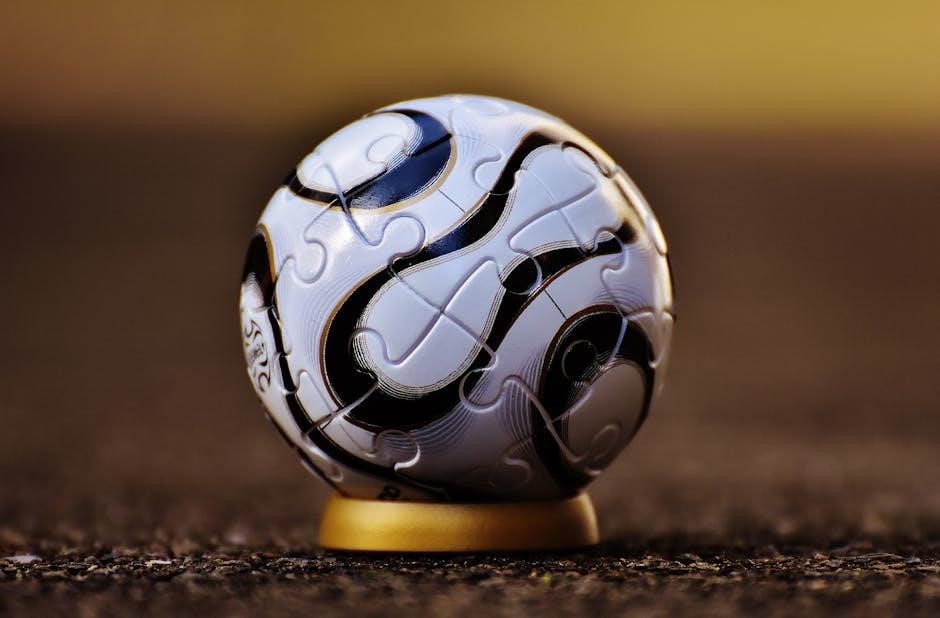
When choosing a soccer ball, consider your skill level and playing surface. Advanced players may prefer balls with textured surfaces for better control, while beginners might opt for smoother designs. For grass or turf fields, a ball with durable materials and traction is ideal. Indoor surfaces require lighter balls with less bounce. Skill level also influences size and weight, ensuring the ball feels right for your ability. Proper ball selection enhances performance, accuracy, and comfort, making it easier to master techniques and enjoy the game. Always match the ball to your environment and skill level for the best experience.
Choosing the right soccer ball size is essential for optimal performance. Proper size enhances control, accuracy, and overall enjoyment, ensuring players maximize their potential on the field.
Final Tips for Picking the Perfect Soccer Ball
Ensuring the right fit is crucial for performance. Consider age, skill level, and playing surface when selecting. Proper inflation enhances playability and durability. Choose materials suited to your needs, whether for practice or matches. Always check for FIFA approval for official games. Read reviews and ask for recommendations to find the best option. Proper care and maintenance will extend the ball’s lifespan. By following these tips, you’ll find a ball that meets your needs, improving your game and overall enjoyment. The right soccer ball can make a significant difference in your performance and love for the sport.
The Importance of Proper Fit for Performance
The right soccer ball size significantly impacts performance, ensuring better control, accuracy, and gameplay. A ball that’s too small or large can hinder technique development and overall enjoyment. Proper fit enhances dribbling, passing, and shooting skills, allowing players to master techniques effectively. It also prevents discomfort and potential injuries from improper ball handling. For younger players, a smaller ball helps build coordination and confidence, while adults require a standard size for optimal play. Always prioritize the correct size based on age and skill level to maximize performance and safety on the field. Proper fit is essential for achieving your full potential in soccer.